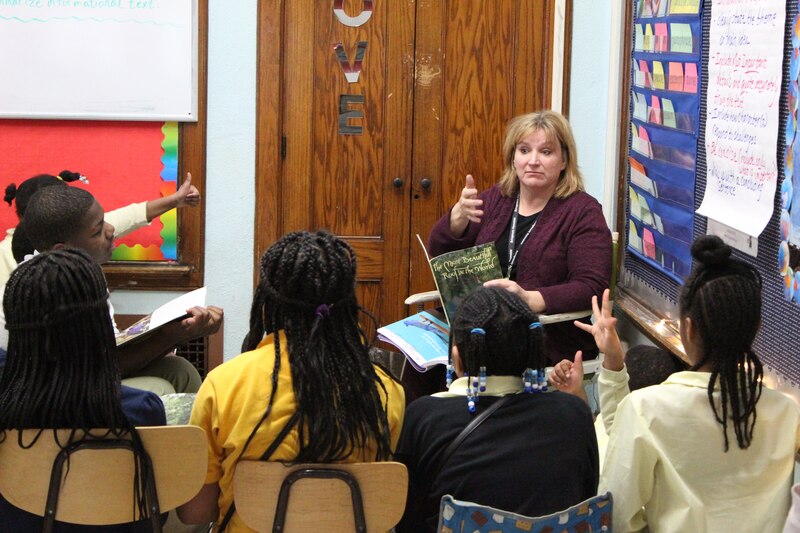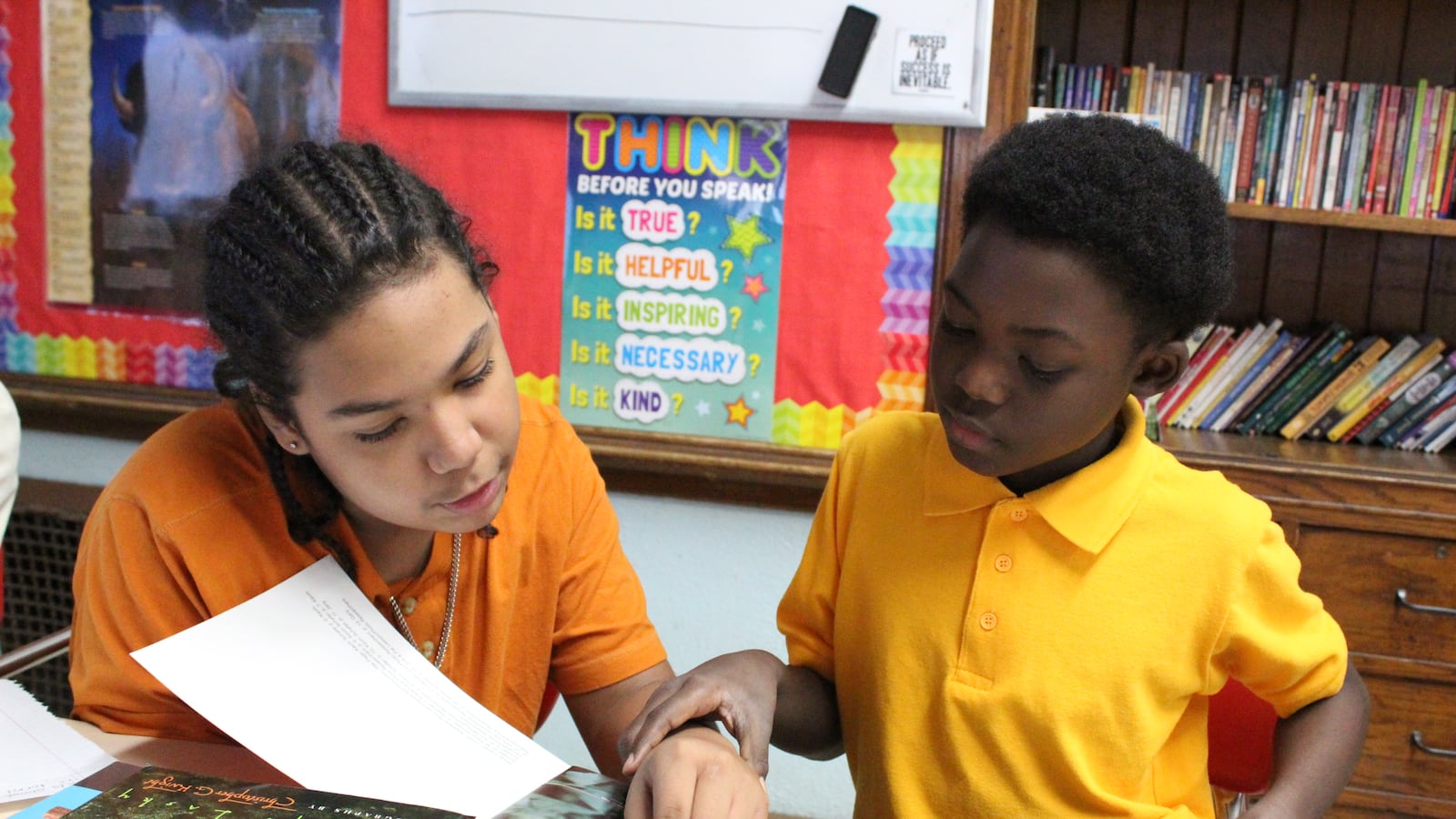This story is the first in an occasional series called “A Morning With,” in which Chalkbeat reporters spend time with the people — students, parents, educators — who are doing the work of education in Detroit.
Class was over and the students in Holly Longo’s fifth-grade reading class were walking single-file out of her room, headed for a math lesson across the hall, when one student stopped, approached his teacher — and completely made her day.
Longo had just wrapped up a lesson on “The Most Beautiful Roof in the World,” a nonfiction story about a biologist who brings her children on a trip to study a rainforest canopy. The book is challenging, and many of her students were clearly struggling to grasp the complex sentences and vocabulary.
The tall, shy boy who approached Longo likely could not have read the rainforest story on his own, but he’d been intrigued by the subject, and now he wanted to share a fact he’d just learned — that rainforests can get 100 inches of annual rainfall. She answered with a wide grin: “Now that surprises me.”
To Longo, this was a win — the kind of moment that keeps 14-year veteran teachers like her going. And the day wasn’t half over yet.
Longo is just one teacher in the Detroit Public Schools Community District, and her teaching strategies and style are her own.
But spend a morning in her class at Palmer Park Preparatory Academy — as Chalkbeat did in January — and you begin to get a sense of challenges facing the district, as well as its reasons to be hopeful. The obstacles facing the students in Longo’s room 117 are familiar to thousands of teachers across the district. If teachers like Longo can help them succeed, then the district has a real chance to recover from decades of disinvestment.

10:52 a.m.
“‘Descend’ — Mariah, what does ‘descend’ mean?” Longo asks.
“To go downward?” comes the reply.
“Yes. And we’re specifically talking about climbing.”
Longo is giving the class footholds in the text, preparing them for the vocabulary they are about to hear. It won’t be easy. The book is part of the district’s challenging new K-8 curriculum, designed for students who are doing age-appropriate work. But a quarter of Longo’s fifth-graders are still sounding out basic words and phrases on a kindergarten or first-grade level.
For years their teachers used outdated lessons that the superintendent called “an injustice to the children of Detroit.”
The new curriculum adopted this year had words that even Longo did not understand. “I was stumbling over it, too,” she acknowledged after class.
But to Longo, that’s a good thing. The rainforest unit has sparked her students’ curiosity — witness the boy who came up to her after class. She believes that interested students are better learners, whether they’re working on higher-level thinking skills or improving their reading fundamentals.
11:23 a.m.
When the class finishes reading together, students pair up for further research on rainforests. They’re allowed to pick books from the class library, which includes texts for all skill levels.
They read aloud to each other, writing down interesting facts as they come across them.
This, Longo says, is the other part of the equation. Challenging, engaging lessons aren’t enough on their own. Students who are behind in reading also need help catching up.
“Practicing at their level is also important,” Longo said. “They need more independent reading time.”
Longo’s students spend an hour a day using iReady, a computer program that tailors reading lessons to students’ abilities. For the children who are furthest behind, iReady produces lessons on phonics, the approach to literacy that is best supported by research.
Longo’s classroom doesn’t have a trained aide to help students catch up on key reading skills.
It’s hard to pick out the struggling readers in her class because most of them participate enthusiastically during the discussion.
“When we’re reading out loud, they can participate, because they’re picking things up orally,” she explained. “Is that a disservice to them when they get out in the world? Only if they don’t have enough practice at their level, too.”
12:46 a.m.
Longo is sitting in class during her lunch period when a student appears at the door.
“Ms. Longo, can I stay in here for gym?”
“Why?”
The answer comes out in a tumble of words: A boy threw something at her, and the teacher didn’t do anything about it….
“Come here,” Longo says gently, and offers the child a hug and a puzzle.
Longo knew she wanted to be a teacher when she was a child, but getting to the front of the classroom wouldn’t be easy. Unable to afford college, she worked for years in customer service.
When she finally was certified as an elementary school teacher, she was interested in Detroit, but the pay was too low. Then, in Vitti’s first year on the job, he and the Detroit teachers union agreed on a raise pay for all teachers, and to honor the prior experience of teachers who were new to the District. Longo took a job.
She glanced around her new classroom, taking in the desks, the books on the wall, and the student doing a puzzle in the reading area at the back of the room.
“I could picture myself staying here for a long time,” she said.

